An Evolutionary Approach to Technology Innovation of Cadastre for Smart Land Management Policy
Abstract
1. Introduction
2. Research Methodology
- Data were extracted from www.scopus.com (3548 papers in total) using the keywords “cadastral” that included major keyword such as “cadastre,” “cadastration,” and “land administration,” which most frequently used words in cadastral fields. Research information was extracted from the following databases: the Web of Science (WoS), SciFiner, and Google Scholar; the functionality of these databases is similar to that of Scopus. Combining these search engines is expensive and time-consuming, and leads to overlapping results. We therefore selected Scopus, which is the most comprehensive database.We extracted nouns from the data from 1987 to 2019 and generated inter-keyword matrix and inter-network matrix data.
- We visualized the evolution of cadastral research using VOS viewer to examine temporal changes in the keyword network.
- We used social network analysis to group the data, and high-frequency keywords were selected for further consideration.
- We analyzed high-ranking keywords using centrality index comparisons.
- Based on institutional network analysis results, we attempted a two-mode network analysis to understand and present institutional relationships.
- We attempted to understand the intergroup network in detail through group density analysis.
3. Results
3.1. Evolutions Over Time
3.2. Network Characteristics of Cadastral Research for Technology Innovation
3.2.1. Characteristics of Cluster Network
3.2.2. Network Structure Using the Centrality Index
3.2.3. Group Network and Group Density
4. Conclusions and Discussion
4.1. Conclusions
4.2. Discussion
Conflicts of Interest
Appendix A
| G1 (real estate) | G2 (legal system) | G3 (land administration) | G4 (urban planning) | G5 (land use) | ||||||||||
|---|---|---|---|---|---|---|---|---|---|---|---|---|---|---|
| Keywords | Code | N | Keywords | Code | N | Keywords | Code | N | Keywords | Code | N | Keywords | Code | N |
| Cadastre | c-0001 | 136 | cadastral | c-0008 | 15 | Land administration | c-0002 | 80 | 3D cadastre | c-0003 | 39 | GIS | c-0004 | 38 |
| Cadastral map | c-0005 | 32 | Cadastral survey | c-0009 | 15 | Land registration | c-0010 | 15 | Cadastral maps | c-0006 | 19 | Land use | c-0018 | 10 |
| Stable cadastre | c-0021 | 9 | Land tenure | c-0012 | 13 | Land registry | c-0013 | 12 | Land cadastre | c-0007 | 18 | land | c-0023 | 8 |
| Administration | c-0030 | 6 | Property rights | c-0014 | 11 | Cadastral system | c-0016 | 10 | Cadastre | c-0011 | 13 | Land administration system | c-0035 | 6 |
| Property | c-0077 | 4 | Land reform | c-0019 | 9 | Real estate cadastre | c-0020 | 9 | Cadastral surveying | c-0015 | 10 | Marine cadastre | c-0037 | 6 |
| Coordinate transformation | c-0061 | 4 | Cadastral data | c-0022 | 8 | LADM | c-0026 | 7 | GPS | c-0017 | 10 | Land administration systems | c-0036 | 6 |
| 3D property | c-0053 | 4 | Land register | c-0024 | 8 | accuracy | c-0025 | 7 | Real estate | c-0027 | 7 | Land use planning | c-0047 | 5 |
| Building cadastre | c-0055 | 4 | Turkey | c-0039 | 6 | Sustainable development | c-0028 | 7 | Datab#ase | c-0033 | 6 | Spatial data infrastructure | c-0050 | 5 |
| Data model | c-0062 | 4 | Cadastral database | c-0040 | 5 | uml | c-0029 | 7 | Cultural landscape | c-0032 | 6 | Housing | c-0065 | 4 |
| Photogrammetry | c-0076 | 4 | Cadastral parcel | c-0044 | 5 | Record | c-0038 | 6 | Topology | c-0051 | 5 | Italy | c-0066 | 4 |
| Public good | c-0078 | 4 | Cadastral information system | c-0041 | 5 | Aerial photographs | c-0031 | 6 | Urban planning | c-0052 | 5 | Land markets | c-0070 | 4 |
| Utility cadastre | c-0089 | 4 | Cadastral management | c-0042 | 5 | Cartography | c-0045 | 5 | Land information system | c-0046 | 5 | Land rights | c-0072 | 4 |
| Cadastral mapping | c-0043 | 5 | Ownership | c-0048 | 5 | Cadastral measurements | c-0057 | 4 | Spatial data | c-0086 | 4 | |||
| Geographic information system | c-0063 | 4 | Parcel | c-0049 | 5 | Cadastral gene | c-0056 | 4 | Standardization | c-0087 | 4 | |||
| Cadastral resurvey project | c-0058 | 4 | Land management | c-0069 | 4 | Reengineering | c-0081 | 4 | Land administration domain model (ladm) | c-0067 | 4 | |||
| Management | c-0075 | 4 | Cadastres | c-0059 | 4 | Remote sensing | c-0083 | 4 | Land parcel | c-0071 | 4 | |||
| Surveying | c-0088 | 4 | Coordinate system | c-0060 | 4 | |||||||||
| Australia | c-0054 | 4 | Homogenization | c-0064 | 4 | |||||||||
| Landscape change | c-0073 | 4 | Land consolidation | c-0068 | 4 | |||||||||
| Rural landscape | c-0084 | 4 | Land tax | c-0074 | 4 | |||||||||
| Slovenia | c-0085 | 4 | Real property | c-0080 | 4 | |||||||||
| Registration | c-0082 | 4 | ||||||||||||
| Real estate property | c-0079 | 4 | ||||||||||||
| Keywords | Code | Group | Num. | In-Degree Centrality | Rank | In-Closeness | Node Betweenness Centrality | Eigenvector Centrality |
|---|---|---|---|---|---|---|---|---|
| Property rights | c-0014 | G2 | 11 | 10.28859 | 1 | 0.873656 | 0.061366 | 0.480301 |
| Cadastral survey | c-0009 | G2 | 15 | 4.47651 | 2 | 0.767338 | 0.065728 | 0.203429 |
| Aerial photographs | c-0031 | G3 | 6 | 3.738255 | 3 | 0.700613 | 0.020025 | 0.179902 |
| GIS | c-0004 | G5 | 38 | 3.369128 | 4 | 0.662223 | 0.105017 | 0.257324 |
| Land administration | c-0002 | G3 | 80 | 3.208054 | 5 | 0.763299 | 0.203193 | 0.370056 |
| 3D cadastre | c-0003 | G4 | 39 | 1.57047 | 6 | 0.622433 | 0.037929 | 0.119734 |
| Cadastral maps | c-0006 | G4 | 19 | 1.328859 | 7 | 0.584786 | 0.027394 | 0.107867 |
| Spatial data infrastructure | c-0050 | G5 | 5 | 1.201342 | 8 | 0.599284 | 0.017262 | 0.071226 |
| Land registration | c-0010 | G3 | 15 | 0.979866 | 9 | 0.519809 | 0.009563 | 0.128593 |
| Record | c-0038 | G3 | 6 | 0.979866 | 10 | 0.559949 | 0.004723 | 0.073295 |
| LADM | c-0026 | G3 | 7 | 0.959732 | 11 | 0.56212 | 0.016535 | 0.075544 |
| Real estate | c-0027 | G4 | 7 | 0.912752 | 12 | 0.564307 | 0.042504 | 0.099772 |
| Land registry | c-0013 | G3 | 12 | 0.744966 | 13 | 0.529295 | 0.009868 | 0.066123 |
| Land cadastre | c-0007 | G4 | 18 | 0.724832 | 14 | 0.537136 | 0.015275 | 0.101859 |
| Cadastral | c-0008 | G2 | 15 | 0.711409 | 15 | 0.547271 | 0.087137 | 0.245886 |
| Governance | c-0111 | G1 | 3 | 0.691275 | 16 | 0.573229 | 0.009751 | 0.03124 |
| Cadastral map | c-0005 | G1 | 32 | 0.684564 | 17 | 0.545214 | 0.02987 | 0.115427 |
| Real estate cadastre | c-0020 | G3 | 9 | 0.604027 | 18 | 0.529295 | 0.006791 | 0.052356 |
| Standardization | c-0087 | G5 | 4 | 0.597315 | 19 | 0.541145 | 0.005873 | 0.02907 |
| GPS | c-0017 | G4 | 10 | 0.503356 | 20 | 0.531234 | 0.004141 | 0.036368 |
| Marine cadastre | c-0037 | G5 | 6 | 0.503356 | 21 | 0.533187 | 0.001397 | 0.033155 |
| Cadastral data | c-0022 | G2 | 8 | 0.463087 | 22 | 0.529295 | 0.006733 | 0.040941 |
| Stable cadastre | c-0021 | G1 | 9 | 0.42953 | 23 | 0.521679 | 0.004719 | 0.035984 |
| Land use | c-0018 | G5 | 10 | 0.416107 | 24 | 0.523563 | 0.016884 | 0.097905 |
| Multipurpose cadastre | c-0127 | G3 | 3 | 0.416107 | 25 | 0.51428 | 0.001374 | 0.028968 |
| Cadastre | c-0011 | G4 | 13 | 0.409396 | 26 | 0.52737 | 0.004459 | 0.032614 |
| Cadastral database | c-0040 | G2 | 5 | 0.369128 | 27 | 0.51428 | 0.003961 | 0.025503 |
| DAZD (State archive in Zadar) | c-0136 | G5 | 3 | 0.369128 | 28 | 0.507087 | 0.001656 | 0.01806 |
| Land register | c-0024 | G2 | 8 | 0.33557 | 29 | 0.480221 | 0.003747 | 0.041502 |
| Surveying | c-0088 | G2 | 4 | 0.33557 | 30 | 0.52737 | 0.005663 | 0.031123 |
References
- Billen, R.; Zlatanova, S. 3D spatial relationships model: A useful concept for 3D cadastre? Comput. Environ. Urban Syst. 2003, 27, 411–425. [Google Scholar] [CrossRef]
- Shojaei, D.; KalantariIan, M.; Bishop, I.D.; Rajabifard, A.; Aien, A. Visualization requirements for 3D cadastral systems. Comput. Environ. Urban Syst. 2013, 41, 39–54. [Google Scholar] [CrossRef]
- Aien, A.; Kalantari, M.; Rajabifard, A.; Williamson, I.; Wallace, J. Towards integration of 3D legal and physical objects in cadastral data models. Land Use Policy 2013, 35, 140–154. [Google Scholar] [CrossRef]
- Stoter, J.E.; van Oosterom, P. Technological aspects of a full 3D cadastral registration. Int. J. Geogr. Inf. Sci. 2005, 19, 669–696. [Google Scholar] [CrossRef]
- Stoter, J.; Salzmann, M. Towards a 3D cadastre: Where do cadastral needs and technical possibilities meet? Comput. Environ. Urban Syst. 2003, 27, 395–410. [Google Scholar] [CrossRef]
- Selleri, M.; Fabrizi, C. The role of ICT in the devolution of cadastral service. In Proceedings of the FIG 2003 Strategies for Renewal of Information Systems and Information Technology for Land Registry and Cadastre, Symposium held by the FIG Commission, Enschede, The Netherlands, 8–9 May 2003. [Google Scholar]
- van Oosterom, P.; Lemmen, C.; De By, R.; Tuladar, A. Geo-ICT technology push vs. cadastral market pull. In Proceedings of the OEEPE Workshop on the Next Generation Spatial Databases, Southampton, UK, 22–24 May 2002. [Google Scholar]
- Silva, M.A.; Stubkjær, E. A review of methodologies used in research on cadastral development. Comput. Environ. Urban Syst. 2002, 26, 403–423. [Google Scholar] [CrossRef]
- Bender, O.; Boehmer, H.J.; Jens, D.; Schumacher, K.P. Analysis of land-use change in a sector of Upper Franconia (Bavaria, Germany) since 1850 using land register records. Landsc. Ecol. 2005, 20, 149–163. [Google Scholar] [CrossRef]
- Skånes, H.M.; Bunce, R.G.H. Directions of landscape change (1741–1993) in Virestad, Sweden—Characterised by multivariate analysis. Landsc. Urban Plan. 1997, 38, 61–75. [Google Scholar] [CrossRef]
- Van Oosterom, P.; Lemmen, C.; Ingvarsson, T.; van der Molen, P.; Ploeger, H.; Quak, W.; Stoter, J.; Zevenbergen, J. The core cadastral domain model. Comput. Environ. Urban Syst. 2006, 30, 627–660. [Google Scholar] [CrossRef]
- Navratil, G.; Frank, A.U. Processes in a cadastre. Comput. Environ. Urban Syst. 2004, 28, 471–486. [Google Scholar] [CrossRef]
- Olfat, H.; Shojaei, D.; Briffa, M.; Maley, S.; Rajabifard, A. Strategic actions for increasing the submission of digital cadastral data by the surveying industry based on lessons learned from Victoria, Australia. ISPRS Int. J. Geo Inf. 2018, 7, 47. [Google Scholar] [CrossRef]
- Van Oosterom, P. Research and development in 3D cadastres. Comput. Environ. Urban Syst. 2013, 40, 1–6. [Google Scholar] [CrossRef]
- Williamson, I.P. The evolution of modern cadastres. In Proceedings of the New Technology for a New Century Conference, FWW2001, Seoul, Korea, 8 May 2001. [Google Scholar]
- Assefa, S.G.; Rorissa, A. A bibliometric mapping of the structure of STEM education using co-word analysis. J. Am. Soc. Inf. Sci. Technol. 2013, 64, 2513–2536. [Google Scholar] [CrossRef]
- Abejón, R.; Pérez-Acebo, H.; Garea, A. A bibliometric analysis of research on supported ionic liquid membranes during the 1995–2015 period: Study of the main applications and trending topics (Open Access). Membranes 2017, 7, 63. [Google Scholar] [CrossRef] [PubMed]
- Aleixandre-Benavent, R.; Aleixandre-Tudó, J.L.; Castelló-Cogollos, L.; Aleixandre, J.L. Trends in global research in deforestation. A bibliometric analysis. Land Use Policy 2018, 72, 293–302. [Google Scholar] [CrossRef]
- Bielecka, E.; Burek, E. Spatial data quality and uncertainty publication patterns and trends by bibliometric analysis (Open Access). Open Geosci. 2019, 11, 219–235. [Google Scholar] [CrossRef]
- Chen, Q.; Geng, N.; Zhu, K. Review and bibliometric analysis of Chinese agricultural economics research: 2006–2015. China Agric. Econ. Rev. 2018, 10, 152–172. [Google Scholar] [CrossRef]
- Chiu, W.-T.; Ho, Y.-S. Bibliometric analysis of homeopathy research during the period of 1991 to 2003. Scientometrics 2005, 63, 3–23. [Google Scholar] [CrossRef]
- Goyal, N. A “review” of policy sciences: Bibliometric analysis of authors, references, and topics during 1970–2017. Policy Sci. 2017, 50, 527–537. [Google Scholar] [CrossRef]
- Güzeller, C.O.; Çeliker, N. Gastronomy from past to today: A bibliometrical analysis. J. Tour. Gastr. Stud. 2017, 5, 88–102. [Google Scholar] [CrossRef]
- Hood, W.W.; Wilson, C.S. The literature of bibliometrics, scientometrics, and informetrics. Scientometrics 2001, 52, 291–314. [Google Scholar] [CrossRef]
- Kasemodel, M.C.; Makishi, F.; Souza, R.C.; Silva, V.-L. Following the trail of crumbs: A bibliometric study on consumer behavior in the Food Science and Technology field (Open Access). Int. J. Food Stud. 2016, 5, 73–83. [Google Scholar] [CrossRef]
- Li, N.; Han, R.; Lu, X. Bibliometric analysis of research trends on solid waste reuse and recycling during 1992–2016. Resour. Conserv. Recyl. 2018, 130, 109–117. [Google Scholar] [CrossRef]
- Liu, F.; Lin, A.; Wang, H.; Peng, Y.; Hong, S. Global research trends of geographical information system from 1961 to 2010: A bibliometric analysis. Scientometrics 2016, 106, 751–768. [Google Scholar] [CrossRef]
- Ye, Z.; Zhang, B.; Liu, Y.; Zhang, J.; Wang, Z.; Bi, H. A bibliometric investigation of research trends on sulfate removal. Desalin. Water Treat. 2014, 52, 6040–6049. [Google Scholar] [CrossRef]
- Polat, Z.A. Evolution and future trends in global research on cadastre: A bibliometric analysis. GeoJournal 2019, 84, 1121–1134. [Google Scholar] [CrossRef]
- Zhang, H.; Huang, M.; Qing, X.; Li, G.; Tian, C. Bibliometric analysis of global remote sensing research during 2010–2015 (Open Access). ISPRS Int. J. Geo Inf. 2017, 6, 332. [Google Scholar] [CrossRef]
- Niu, J.; Tang, W.; Xu, F.; Zhou, X.; Song, Y. Global research on artificial intelligence from 1990-2014: Spatially-explicit bibliometric analysis (Open Access). ISPRS Int. J. Geo Inf. 2016, 5, 66. [Google Scholar] [CrossRef]
- Tian, Y.; Wen, C.; Hong, S. Global scientific production on GIS research by bibliometric analysis from 1997 to 2006. J. Informetr. 2008, 2, 65–74. [Google Scholar] [CrossRef]
- Ackerly, D.D.; Loarie, S.R.; Cornwell, W.K.; Weiss, S.B.; Hamilton, H.; Branciforte, R.; Kraft, N.J.B. The geography of climate change: Implications for conservation biogeography. Divers. Distrib. 2010, 16, 476–487. [Google Scholar] [CrossRef]
- E Fonseca, B.P.F.; Sampaio, R.B.; Fonseca, M.V.A.; Zicker, F. Co-authorship network analysis in health research: Method and potential use (Open Access). Health Res. Policy Syst. 2016, 14, 34. [Google Scholar] [CrossRef] [PubMed]
- Nepal, S.K. Traditions and trends: A review of geographical scholarship in tourism. Tour. Geogr. 2009, 11, 2–22. [Google Scholar] [CrossRef]
- Zevenbergen, J. A systems approach to land registration and Cadastre. Nord. J. Surv. Real Estate Res. 2004, 1, 11–24. [Google Scholar]
- Nohria, N.; Eccles, R.G. School, Networks and Organizations: Structure, Form, and Action; Harvard Business School Press: Boston, MA, USA, 1992. [Google Scholar]
- Wasserman, S.; Galaskiewicz, J. Advances in Social Network Analysis: Research in the Social and Behavioral Sciences; Sage Publications Inc.: Thousand Oaks, CA, USA, 1994. [Google Scholar]
- Wellman, B.; Berkowitz, S.D. Introduction: Studying social structures. In Social Structures: A Network Approach; Cambridge University Press: Cambridge, MA, USA, 1988; pp. 1–14. [Google Scholar]
- Su, H.-N.; Lee, P.C. Network perspective of science and technology policy research community in Taiwan. In Proceedings of the Technology Management for Global Economic Growth (PICMET), Phuket, Thailand, 18–22 July 2010. [Google Scholar]
- Van Eck, N.J.; Waltman, L. 2013 VOS Viewer Manual, Manual for VOS Viewer Version 1.5.4. Available online: http://www.vosviewer.com/documentation/Manual_VOSviewer_1.5.4.pdf (accessed on 1 December 2019).
- Cho, I.; Kim, N. Recommending core and connecting keywords of research area using social network and data mining techniques. J. Intell. Inf. Syst. 2011, 17, 127–138. [Google Scholar]
- Coulter, N.; Monarch, I.; Konda, S. Software engineering as seen through its research literature: A study in co-word analysis. J. Am. Soc. Inf. Sci. 1998, 49, 1206–1223. [Google Scholar] [CrossRef]
- Callon, M.; Courtial, J.P.; Laville, F. Co-word analysis as a tool for describing the network of interactions between basic and technological research: The case of polymer chemistry. Scientometrics 1991, 22, 155–205. [Google Scholar] [CrossRef]
- Ho, Y.-S. Bibliometric analysis of adsorption technology in environmental science. J. Environ. Prot. Sci. 2007, 1, 1–11. [Google Scholar]
- Chiu, W.-T.; Ho, Y.-S. Bibliometric analysis of tsunami research. Scientometrics 2007, 73, 3–17. [Google Scholar] [CrossRef]
- Kim, H. Notational analysis of sports using social network analysis. Korean J. Meas. Eval. Phys. Educ. Sport Sci. 2007, 9, 99–112. [Google Scholar]
- Leydesdorff, L. The university–industry knowledge relationship: Analyzing patents and the science base of technologies. J. Am. Soc. Inf. Sci. Technol. 2004, 55, 991–1001. [Google Scholar] [CrossRef]
- Leydesdorff, L.; Hellsten, I. Metaphors and diaphors in science communication mapping the case of stem cell research. Sci. Commun. 2005, 27, 64–99. [Google Scholar] [CrossRef]
- Leydesdorff, L.; Welbers, K. The semantic mapping of words and co-words in contexts. J. Inf. 2011, 5, 469–475. [Google Scholar] [CrossRef]
- Fig, F. Statement on the Cadastre. International Federation of Surveyors. Available online: http://www.fig.net/resources/publications/figpub/pub11/figpub11.asp (accessed on 5 December 2019).
- Enemark, S. Global Trends in Land Administration. In Proceedings of the First International Conference of the Arab Union of Surveyors, Beirut, Lebanon, 29 June–1 July 2009. [Google Scholar]
- Williamson, I.P.; Enemark, S.; Wallace, J. Sustainability and Land Administration Systems. In Proceedings of the Expert Group Meeting, Melbourne, VIC, Australia, 9–11 November 2005. [Google Scholar]
- Bennett, R.; Wallace, J.; Williamson, I. Integrated land administration in Australia: The need to align ICT strategies and operations. In Proceedings of the SSC 2005 Spatial Intelligence, Innovation and Praxis: The national biennial Conference of the Spatial Sciences Institute, September 2005; Spatial Sciences Institute: Melbourne, VIC, Australia, 2005. [Google Scholar]
- Kobayashi, S.; Fujioka, T.; Tanaka, Y.; Inoue, M.; Niho, Y.; Miyoshi, A. A geographical information system using the google map API for guidance to referral hospitals. J. Med. Syst. 2010, 34, 1157–1160. [Google Scholar] [CrossRef] [PubMed]
- Purves, R.; Jones, C. Geographic Information Retrieval (GIR). Comput. Environ. Urban Syst. 2006, 30, 375–377. [Google Scholar] [CrossRef]
- Derbal, K.; Bordogna, G.; Pasi, G.; Alimazighi, Z. Spatial querying supported by domain and user ontologies: An approach for web GIS applications. Adv. Intell. Syst. Comput. 2016, 400, 353–365. [Google Scholar] [CrossRef]
- Brown, G.; Kelly, M.; Whitall, D. Which ‘public’? Sampling effects in public participation GIS (PPGIS) and volunteered geographic information (VGI) systems for public lands management. J. Environ. Plan. Manag. 2014, 57, 190–214. [Google Scholar] [CrossRef]
- Ballatore, A.; Bertolotto, M.; Wilson, D.C. Geographic knowledge extraction and semantic similarity in OpenStreetMap. Knowl. Inf. Syst. 2013, 37, 61–81. [Google Scholar] [CrossRef]
- McNeill, G.; Bright, J.; Hale, S.A. Estimating local commuting patterns from geolocated Twitter data (Open Access). EPJ Data Sci. 2017, 6, 24. [Google Scholar] [CrossRef]
- Liu, Y.; Wang, F.; Xiao, Y.; Gao, S. Urban land uses and traffic ‘source-sink areas’: Evidence from GPS-enabled taxi data in Shanghai. Landsc. Urban Plan. 2012, 106, 73–87. [Google Scholar] [CrossRef]
- Haklay, M. How good is volunteered geographical information? A comparative study of OpenStreetMap and ordnance survey datasets. Environ. Plan. B 2010, 37, 682–703. [Google Scholar] [CrossRef]
- Mashhadi, A.; Quattrone, G.; Capra, L. The impact of society on volunteered geographic information: The case of OpenStreetMap. Lect. Notes Geoinf. Cartogr. 2015, 9783319142791, 125–141. [Google Scholar] [CrossRef]
- Senaratne, H.; Mobasheri, A.; Ali, A.L.; Capineri, C.; Haklay, M. A review of volunteered geographic information quality assessment methods. Int. J. Geogr. Inf. Sci. 2017, 31, 139–167. [Google Scholar] [CrossRef]
- Williamson, I. Appropriate cadastral systems. Aust. Surv. 1995, 40, 57–59. [Google Scholar] [CrossRef]
- De Meyere, J.C. Cadastral reform in Argentina—An opportunity for system development. Geomat. Info Mag. 1995, 9, 28–30. [Google Scholar]
- Fourie, C.; van Gysen, H. Constructing cadastral reform theory in South Africa. Geomatica 1995, 49, 315–328. [Google Scholar]
- Williamson, I.P. Land administration “best practice” providing the infrastructure for land policy implementation. J. Land Use Policy 2001, 18, 297–307. [Google Scholar] [CrossRef]
- Williamson, I.P. Re-engineering land administration systems for sustainable development- from rhetoric to reality. Int. J. Appl. Earth Obs. Geoinf. 2001, 3, 278–289. [Google Scholar] [CrossRef]
- Steudler, D. Swiss cadastral surveyors’ response to the LIS/GIS challenge. Geomat. Info Mag. 1995, 9, 30–33. [Google Scholar]
- Ofat, H.; Kalantari, M.; Rajabifard, A.; Williamson, I. Towards a foundation for spatial metadata automation. J. Spat. Sci. 2012, 57, 65–81. [Google Scholar] [CrossRef]
- Benhamu, M.; Doytsher, Y. Toward a spatial 3D cadastre in Israel, Computers. Environ. Urnan Syst. 2003, 27, 359–374. [Google Scholar] [CrossRef]
- Stoter, J.E.; van Oosterom, P. 3D Cadastre in an International Context: Legal, Organizational, and Technological Aspects; Taylor&Francis: New York, NY, USA, 2006. [Google Scholar]
- Williamson, I.P. The future role of the cadastre. In Proceedings of the CIES Korea 2005 Cadastral Innovation Expo and Seminar, Seoul, Korea, 4 May 2005; pp. 8–9. [Google Scholar]
- Rajabifard, A.; Binns, A.; Masser, I.; Williamson, I. The role of sub-national government and the private sector in future spatial data infrastructures. Int. J. Geogr. Inf. Sci. 2006, 20, 727–741. [Google Scholar] [CrossRef]
- Lemmen, C.; Van Oosterom, P.; Zevenbergen, J.; Quak, W. Further progress in the development of a core cadastral domain model. In Proceedings of the FIG Working Week, Paris, France, 13–17 April 2003. [Google Scholar]
- Kalantari, M.; Rajabifard, A.; Wallace, J.; Williamson, I. An interoperability toolkit for e-Land administration. In Sustainability and Land Administration Systems; Department of Geomatics: Melbourne, VIC, Australia, 2006; pp. 213–222. [Google Scholar]
- Goodchild, M.F. Citizens as sensors: The world of volunteered geography. GeoJournal 2007, 69, 211–221. [Google Scholar] [CrossRef]
- Spirou-Sioula, K.; Ioannidis, C.; Potsiou, C. Technical aspects for 3D hybrid cadastral model. Surv. Rev. 2013, 45, 419–427. [Google Scholar] [CrossRef]
- Yang, C.S. Development of the process of coordinate transformation of local datum cadastral map to the World Geodetic System—Using adjusted coordinate. J. Korean Soc. Surv. Geod. Photogramm. Cartogr. 2014, 32, 401–412. [Google Scholar] [CrossRef]
- De Vries, W.T.; Bennett, R.M.; Zevenbergen, J.A. Neo-cadastres: Innovative solution for land users without state based land rights, or just reflections of institutional isomorphism? Surv. Rev. 2015, 47, 220–229. [Google Scholar] [CrossRef]
- D’Haeseleer, P.; Liang, S.; Somogyi, R. Genetic network inference: From co-expression clustering to reverse engineering. Bioinformatics 2000, 16, 707–726. [Google Scholar] [CrossRef] [PubMed]
- Carmona, A.; Nahuelhual, L.; Echeverría, C.; Báez, A. Linking farming systems to landscape change: An empirical and spatially explicit study in southern Chile. Agric. Ecosyst. Environ. 2010, 139, 40–50. [Google Scholar] [CrossRef]
- Andrieu, E.; Ladet, S.; Heintz, W.; Deconchat, M. History and spatial complexity of deforestation and logging in small private forests. Landsc. Urban Plan. 2011, 103, 109–117. [Google Scholar] [CrossRef]
- Smith, D.A.; Herlihy, P.H.; Kelly, J.H.; Viera, A.R. The certification and privatization of indigenous lands in Mexico. J. Lat. Am. Geogr. 2009, 8, 175–207. [Google Scholar] [CrossRef]
- Gridan, M.; Jianu, S.; Grecea, C. Implication of forestry cadastre in the national strategy of environmental protection. J. Environ. Prot. Ecol. 2012, 13, 2283–2290. [Google Scholar]
- Masser, I.; Rajabifard, A.; Williamson, I. Spatially enabling governments through SDI implementation. Int. J. Geogr. Inf. Sci. 2008, 22, 5–20. [Google Scholar] [CrossRef]
- Mohammadi, H.; Rajabifard, A.; Williamson, I. Development of an interoperable tool to facilitate spatial data integration in the context of SDI. Int. J. Geogr. Inf. Sci. 2010, 24, 487–505. [Google Scholar] [CrossRef]
- Williamson, I.P.; Enemark, S.; Wallace, J.; Rajabifard, A. Land Administration for Sustainable Development; ESRI Press: Academic Redlands, CA, USA, 2010. [Google Scholar]
- Bennett, R.; Rajabifard, A.; Kalantari, M.; Wallace, J.; Williamson, I. Cadastral futures: Building a new vision for the nature and role of cadastres. In Proceedings of the XXIV FIG International Congress, Sydney, NSW, Australia, 11–15 April 2010. [Google Scholar]
- Steudler, D.; Rajabifard, A. Spatially Enabled Society. In Proceedings of the International Federation of Surveyors (FIG): Copenhagen, the Spatial Science Institute Biennial Conference, Melbourne, VIC, Australia, 12–16 September 2012. [Google Scholar]
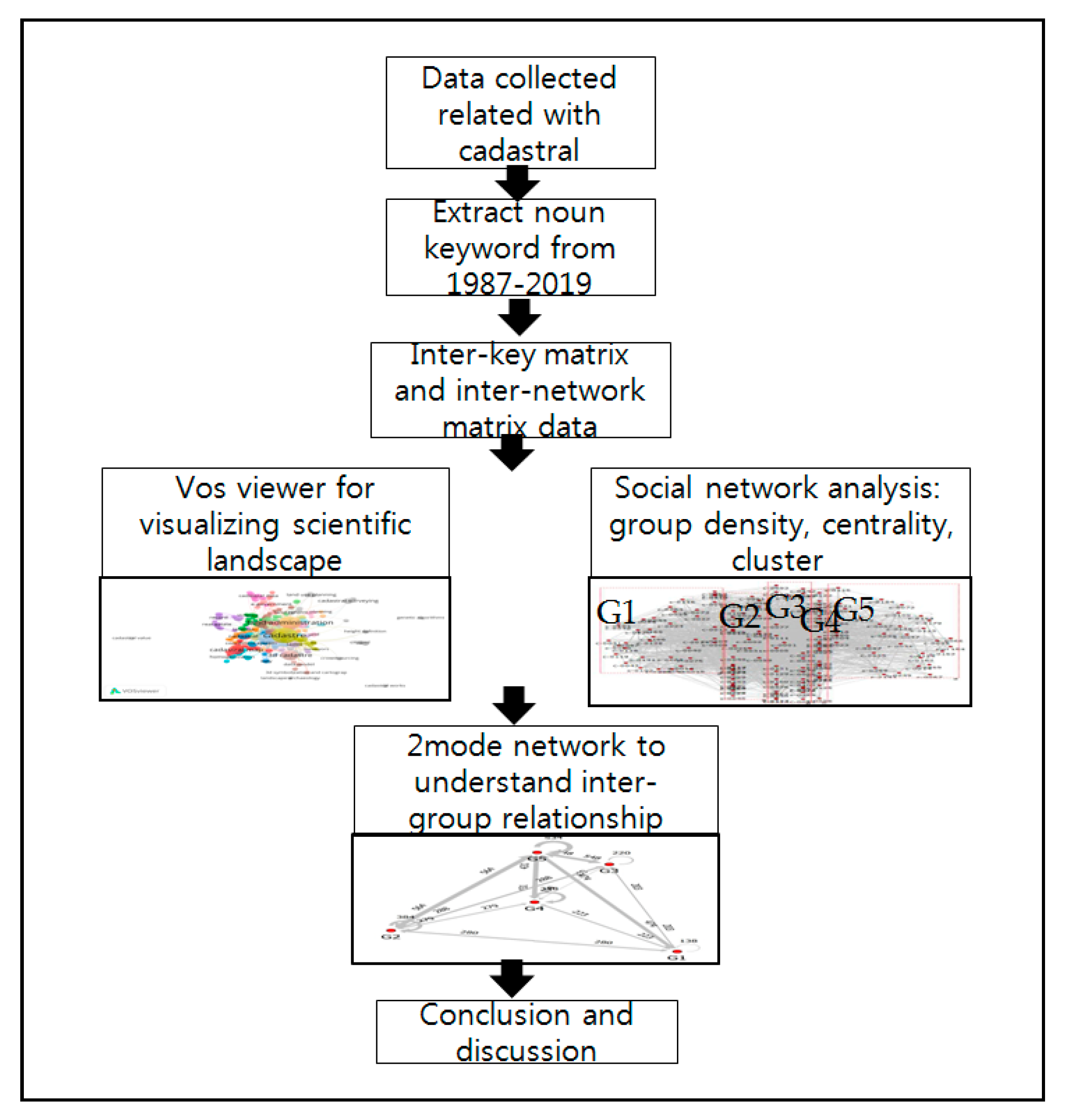
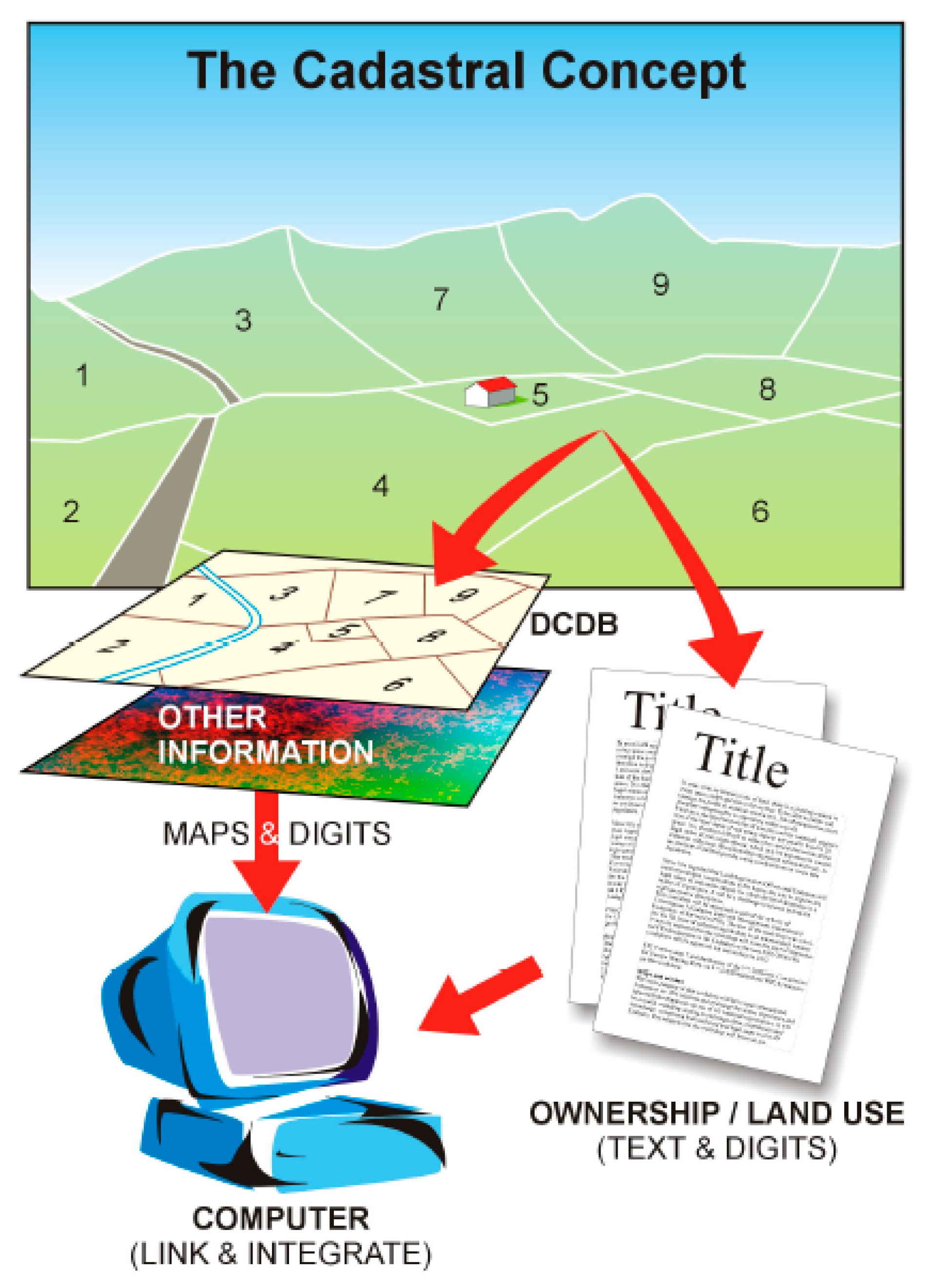
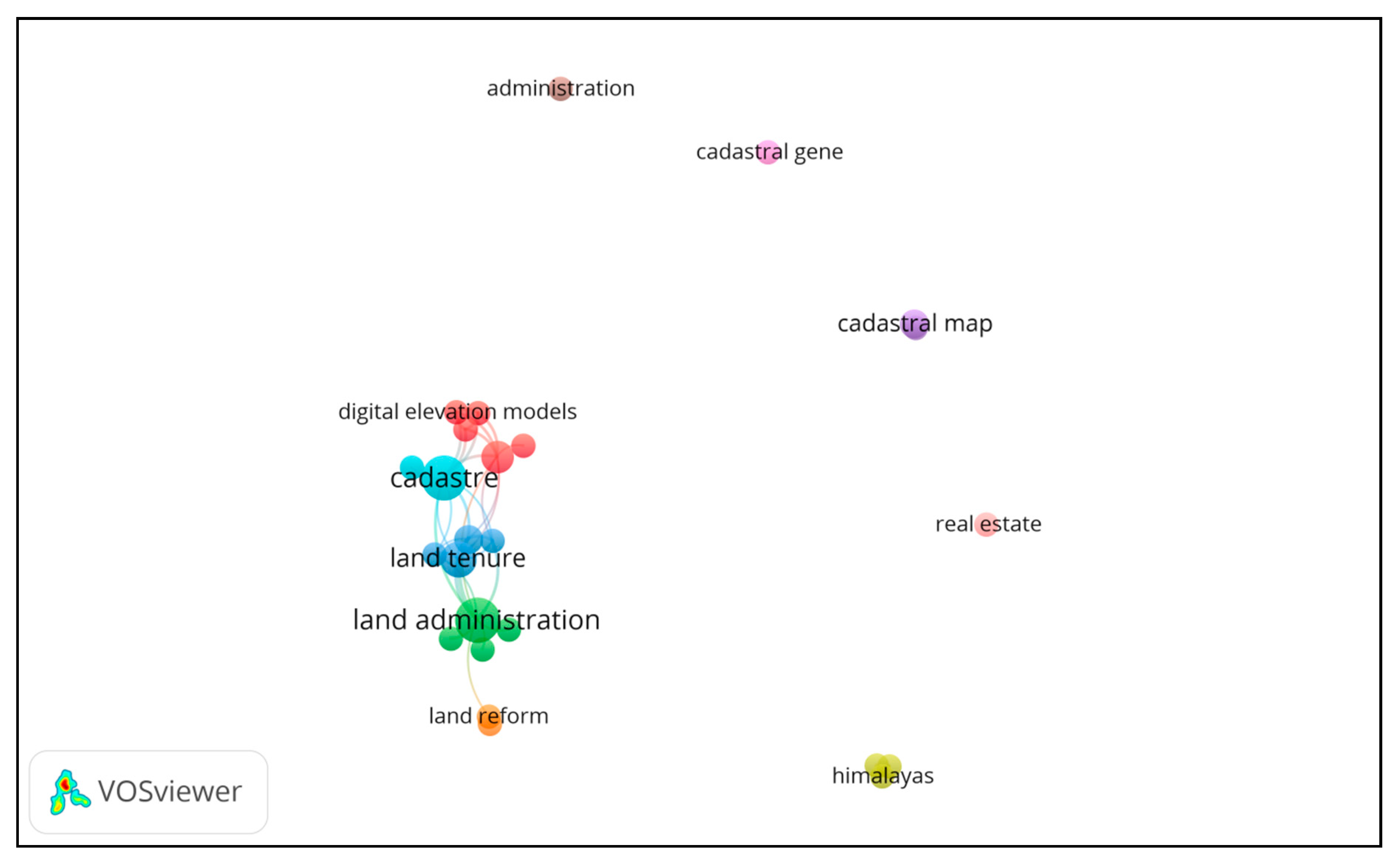
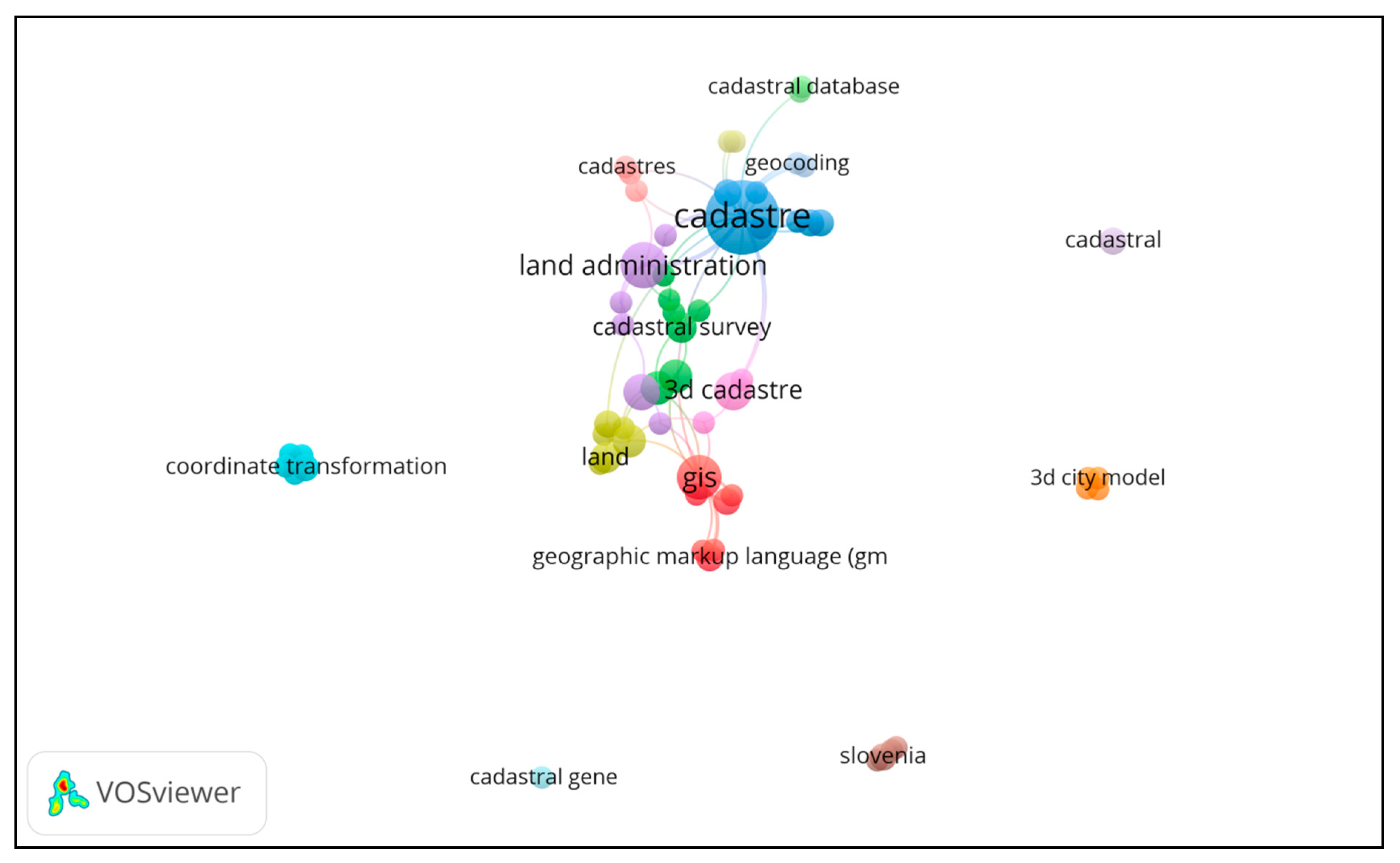
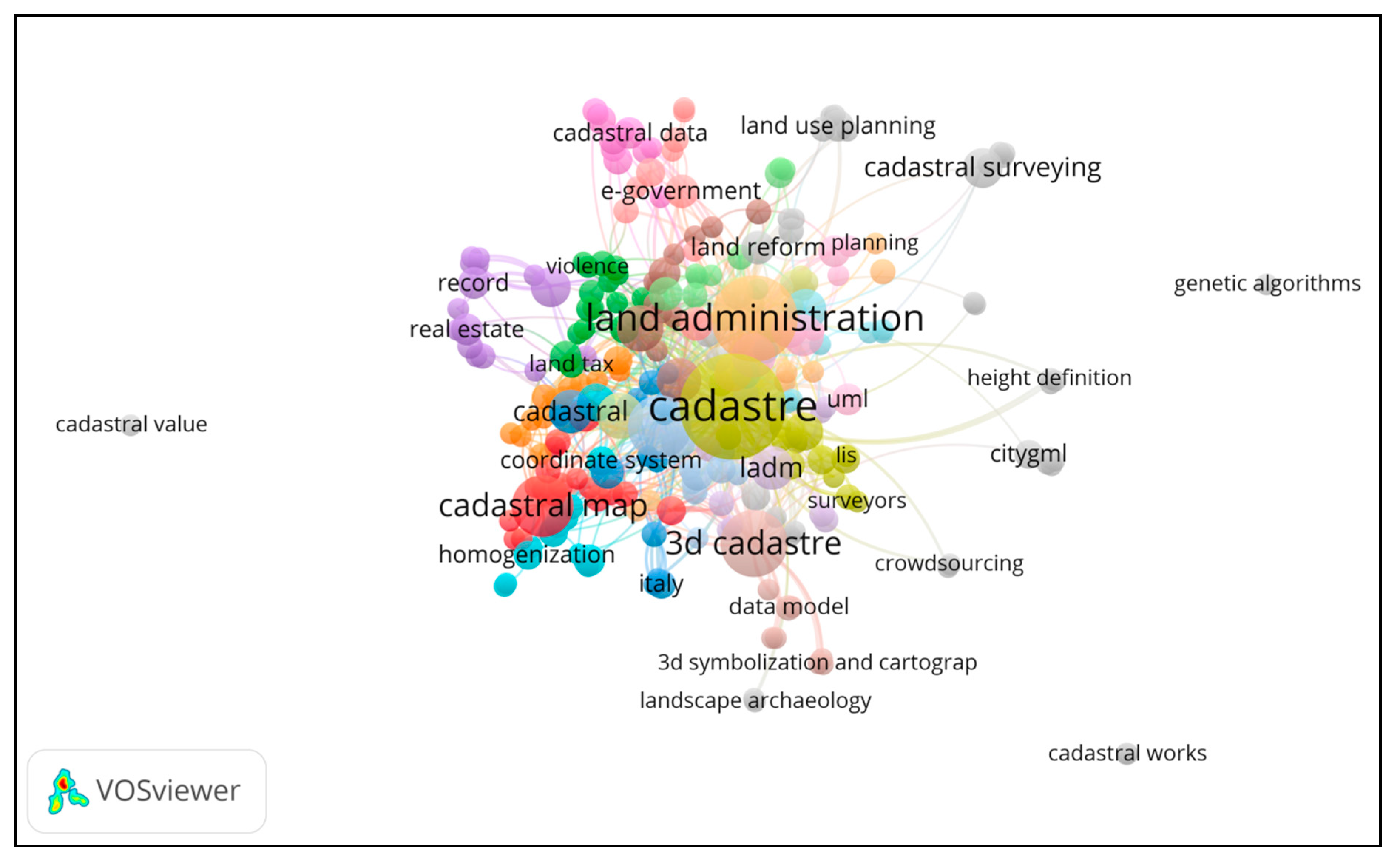
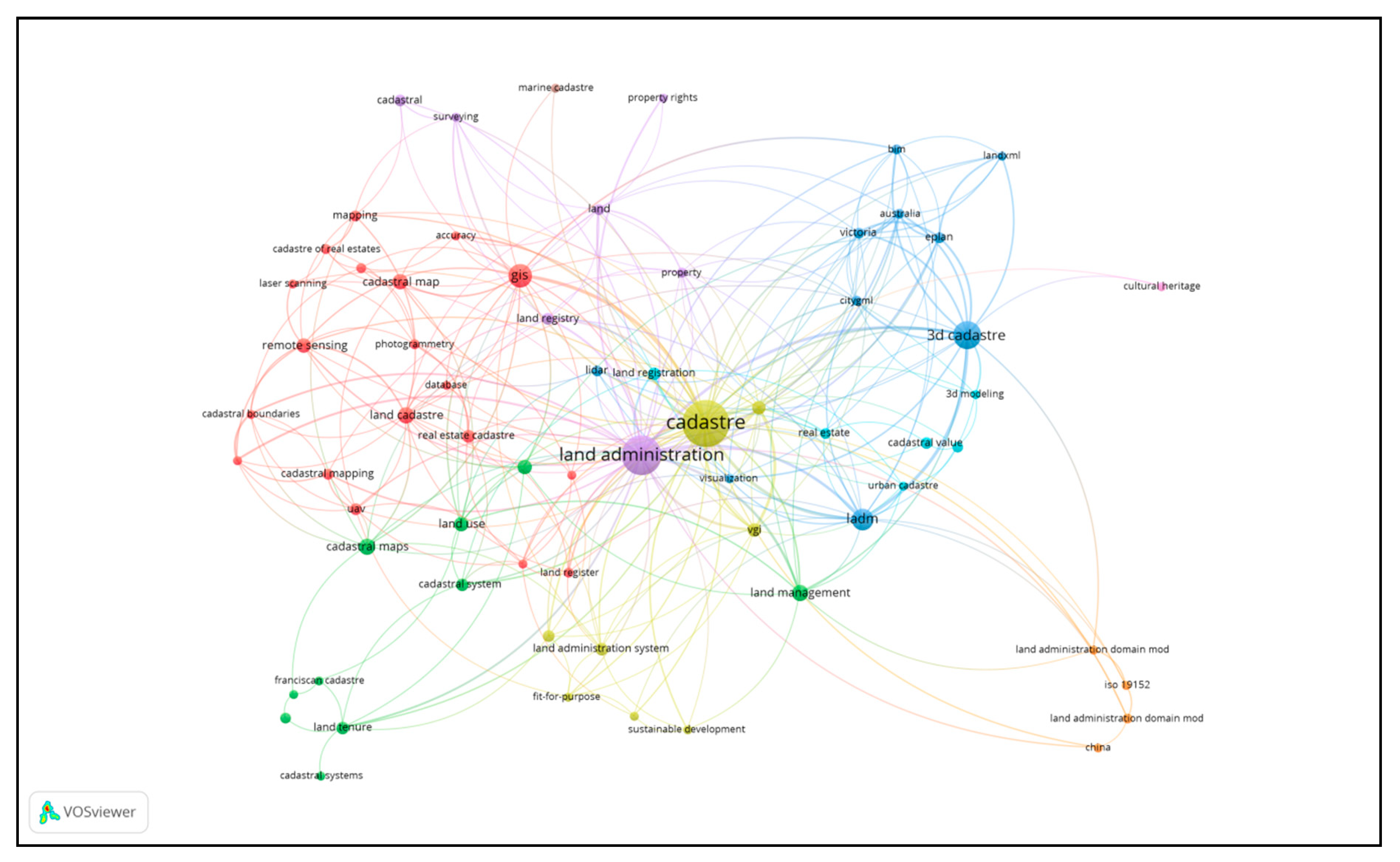
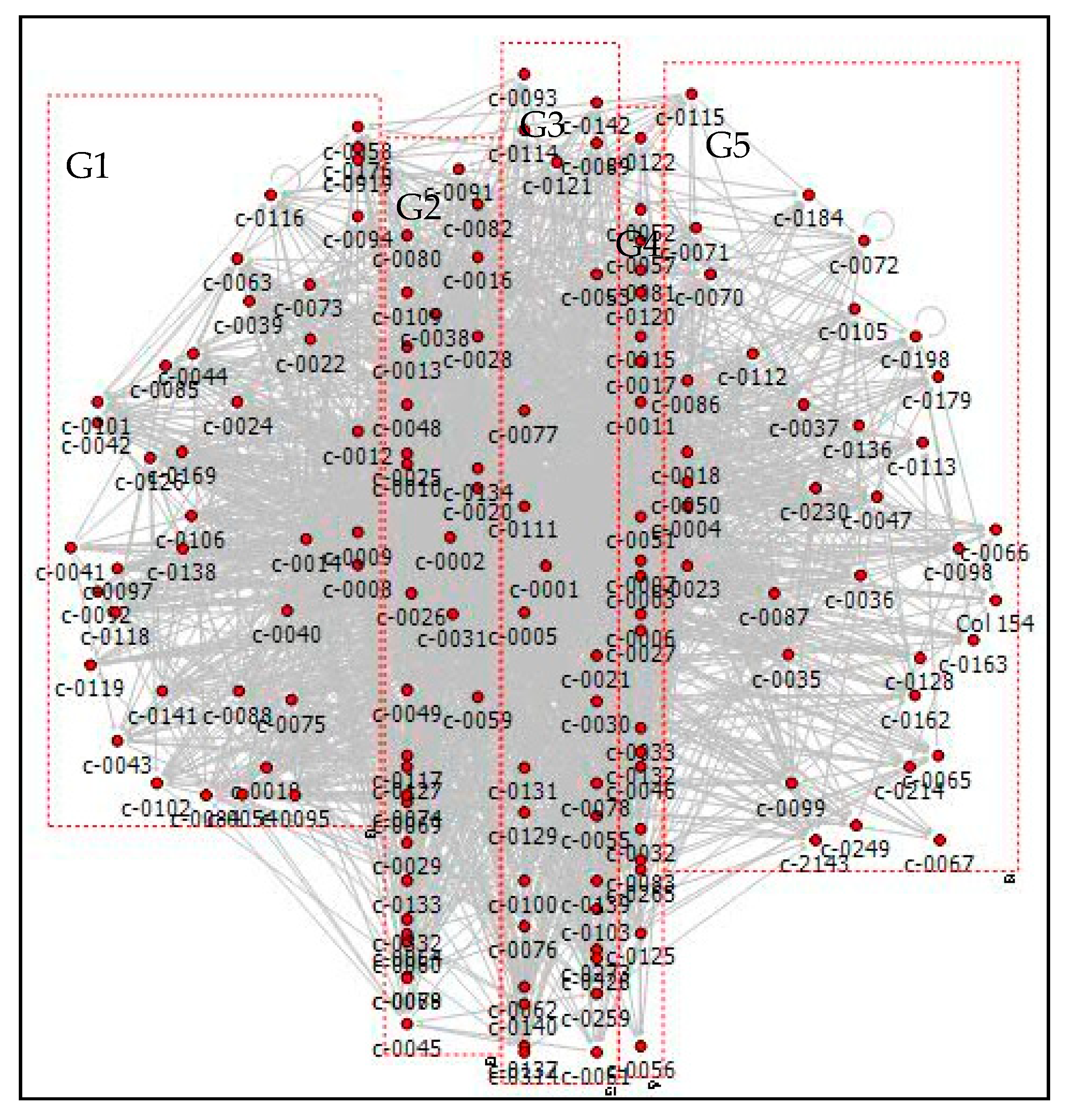
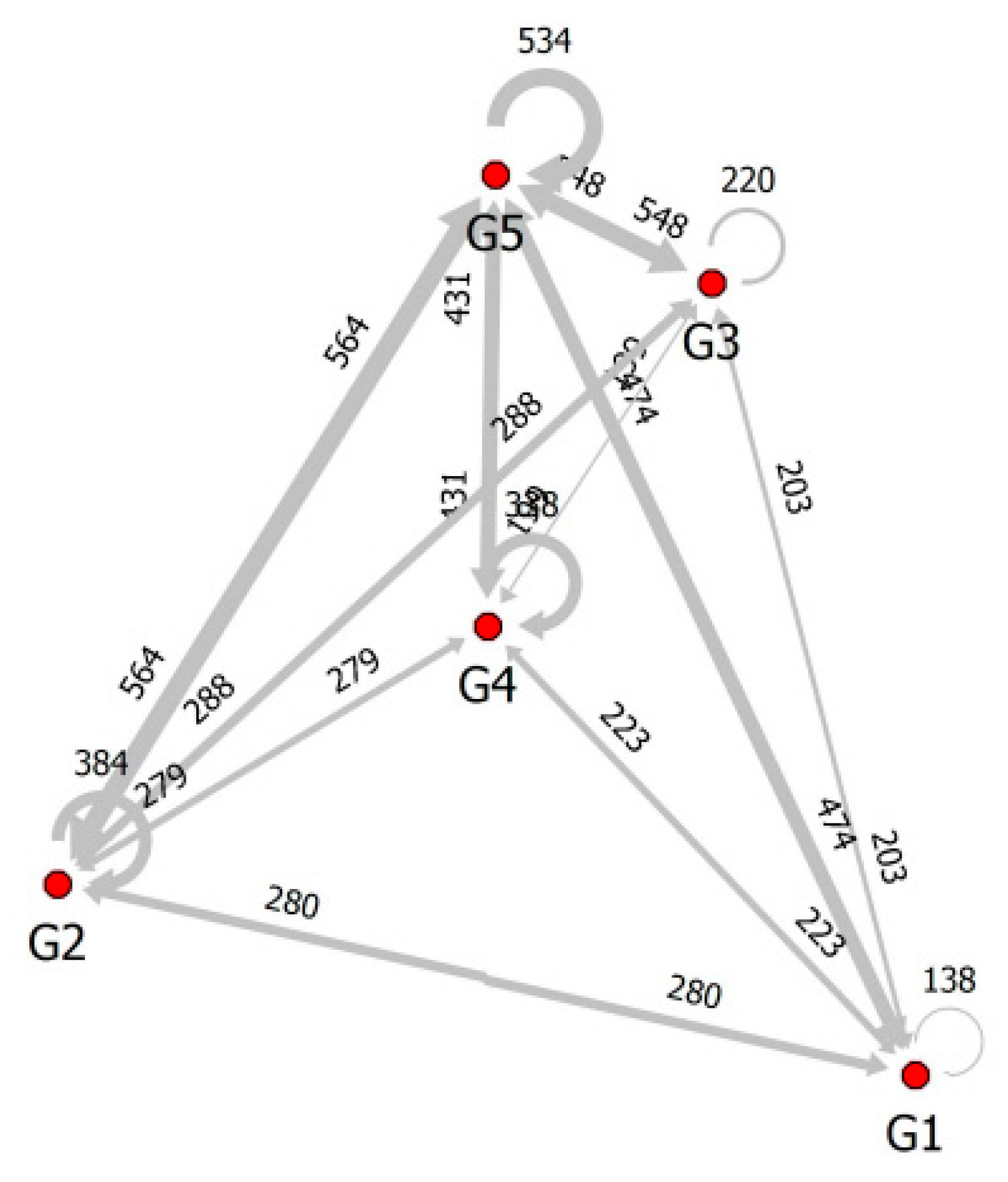
| Density | E-I index | SMI | Cohesion Index | |
|---|---|---|---|---|
| G1 (real estate) | 0.324 | 0.755 | 0.015 | 0.629 |
| G2 (legal system) | 0.54 | 0.66 | 0.145 | 0.644 |
| G3 (land administration) | 0.529 | 0.668 | 0.306 | 0.824 |
| G4 (urban planning) | 0.386 | 0.765 | 0.305 | 0.858 |
| G5 (land use) | 0.619 | 0.663 | 0.144 | 0.713 |
© 2020 by the author. Licensee MDPI, Basel, Switzerland. This article is an open access article distributed under the terms and conditions of the Creative Commons Attribution (CC BY) license (http://creativecommons.org/licenses/by/4.0/).
Share and Cite
Choi, H.O. An Evolutionary Approach to Technology Innovation of Cadastre for Smart Land Management Policy. Land 2020, 9, 50. https://doi.org/10.3390/land9020050
Choi HO. An Evolutionary Approach to Technology Innovation of Cadastre for Smart Land Management Policy. Land. 2020; 9(2):50. https://doi.org/10.3390/land9020050
Chicago/Turabian StyleChoi, Hae Ok. 2020. "An Evolutionary Approach to Technology Innovation of Cadastre for Smart Land Management Policy" Land 9, no. 2: 50. https://doi.org/10.3390/land9020050
APA StyleChoi, H. O. (2020). An Evolutionary Approach to Technology Innovation of Cadastre for Smart Land Management Policy. Land, 9(2), 50. https://doi.org/10.3390/land9020050




